My team has an application that is currently deployed as an azure cloud service. The application works well, but after deploying as an app service (as a continuous web job), we're seeing many types of TLS connection failures. The TLS certificates are loaded into HTTPS clients and TCP socket clients. Why are these breaking when running as an app service?
TCP:
System.ComponentModel.Win32Exception (0x80004005): The credentials supplied to the package were not recognized
System.Net.SSPIWrapper.AcquireCredentialsHandle(SSPIInterface SecModule, String package, CredentialUse intent, SecureCredential scc)
System.Net.Security.SecureChannel.AcquireCredentialsHandle(CredentialUse credUsage, SecureCredential& secureCredential)
System.Net.Security.SecureChannel.AcquireClientCredentials(Byte[]& thumbPrint)
System.Net.Security.SecureChannel.GenerateToken(Byte[] input, Int32 offset, Int32 count, Byte[]& output)
System.Net.Security.SecureChannel.NextMessage(Byte[] incoming, Int32 offset, Int32 count)
System.Net.Security.SslState.StartSendBlob(Byte[] incoming, Int32 count, AsyncProtocolRequest asyncRequest)
System.Net.Security.SslState.ProcessReceivedBlob(Byte[] buffer, Int32 count, AsyncProtocolRequest asyncRequest)
System.Net.Security.SslState.StartReceiveBlob(Byte[] buffer, AsyncProtocolRequest asyncRequest)
System.Net.Security.SslState.CheckCompletionBeforeNextReceive(ProtocolToken message, AsyncProtocolRequest asyncRequest)
System.Net.Security.SslState.ProcessReceivedBlob(Byte[] buffer, Int32 count, AsyncProtocolRequest asyncRequest)
System.Net.Security.SslState.StartReceiveBlob(Byte[] buffer, AsyncProtocolRequest asyncRequest)
System.Net.Security.SslState.CheckCompletionBeforeNextReceive(ProtocolToken message, AsyncProtocolRequest asyncRequest)
System.Net.Security.SslState.ProcessReceivedBlob(Byte[] buffer, Int32 count, AsyncProtocolRequest asyncRequest)
System.Net.Security.SslState.StartReceiveBlob(Byte[] buffer, AsyncProtocolRequest asyncRequest)
System.Net.Security.SslState.CheckCompletionBeforeNextReceive(ProtocolToken message, AsyncProtocolRequest asyncRequest)
System.Net.Security.SslState.ProcessReceivedBlob(Byte[] buffer, Int32 count, AsyncProtocolRequest asyncRequest)
System.Net.Security.SslState.StartReceiveBlob(Byte[] buffer, AsyncProtocolRequest asyncRequest)
System.Net.Security.SslState.CheckCompletionBeforeNextReceive(ProtocolToken message, AsyncProtocolRequest asyncRequest)
System.Net.Security.SslState.ForceAuthentication(Boolean receiveFirst, Byte[] buffer, AsyncProtocolRequest asyncRequest)
System.Net.Security.SslState.ProcessAuthentication(LazyAsyncResult lazyResult)
HTTP:
System.Net.WebException: The underlying connection was closed: Could not establish trust relationship for the SSL/TLS secure channel. ---> System.Security.Authentication.AuthenticationException: The remote certificate is invalid according to the validation procedure.
System.Net.Security.SslState.StartSendAuthResetSignal(ProtocolToken message, AsyncProtocolRequest asyncRequest, Exception exception)
System.Net.Security.SslState.CheckCompletionBeforeNextReceive(ProtocolToken message, AsyncProtocolRequest asyncRequest)
System.Net.Security.SslState.ProcessReceivedBlob(Byte[] buffer, Int32 count, AsyncProtocolRequest asyncRequest)
System.Net.Security.SslState.StartReceiveBlob(Byte[] buffer, AsyncProtocolRequest asyncRequest)
System.Net.Security.SslState.CheckCompletionBeforeNextReceive(ProtocolToken message, AsyncProtocolRequest asyncRequest)
System.Net.Security.SslState.ProcessReceivedBlob(Byte[] buffer, Int32 count, AsyncProtocolRequest asyncRequest)
System.Net.Security.SslState.StartReceiveBlob(Byte[] buffer, AsyncProtocolRequest asyncRequest)
System.Net.Security.SslState.CheckCompletionBeforeNextReceive(ProtocolToken message, AsyncProtocolRequest asyncRequest)
System.Net.Security.SslState.ProcessReceivedBlob(Byte[] buffer, Int32 count, AsyncProtocolRequest asyncRequest)
System.Net.Security.SslState.StartReceiveBlob(Byte[] buffer, AsyncProtocolRequest asyncRequest)
System.Net.Security.SslState.CheckCompletionBeforeNextReceive(ProtocolToken message, AsyncProtocolRequest asyncRequest)
System.Net.Security.SslState.ForceAuthentication(Boolean receiveFirst, Byte[] buffer, AsyncProtocolRequest asyncRequest)
System.Net.Security.SslState.ProcessAuthentication(LazyAsyncResult lazyResult)
System.Threading.ExecutionContext.RunInternal(ExecutionContext executionContext, ContextCallback callback, Object state, Boolean preserveSyncCtx)
System.Threading.ExecutionContext.Run(ExecutionContext executionContext, ContextCallback callback, Object state, Boolean preserveSyncCtx)
System.Threading.ExecutionContext.Run(ExecutionContext executionContext, ContextCallback callback, Object state)
System.Net.TlsStream.ProcessAuthentication(LazyAsyncResult result)
System.Net.TlsStream.Write(Byte[] buffer, Int32 offset, Int32 size)
System.Net.ConnectStream.WriteHeaders(Boolean async) --- End of inner exception stack trace ---
System.Net.HttpWebRequest.GetRequestStream(TransportContext& context)
System.Net.HttpWebRequest.GetRequestStream()
Remote Certificate:
-----BEGIN CERTIFICATE-----
MIIHMDCCBhigAwIBAgIQTVJjt9EMcV3VkbZ5cKqBNzANBgkqhkiG9w0BAQsFADBDMQswCQYDVQQGEwJVUzEVMBMGA1UEChMMdGhhd3RlLCBJbmMuMR0wGwYDVQQDExR0aGF3dGUgU0hBMjU2IFNTTCBDQTAeFw0xNzAxMDkwMDAwMDBaFw0yMDAxMTMyMzU5NTlaMIGJMQswCQYDVQQGEwJVUzEQMA4GA1UECAwHQXJpem9uYTEQMA4GA1UEBwwHUGhvZW5peDEpMCcGA1UECgwgQmVzdCBXZXN0ZXJuIEludGVybmF0aW9uYWwsIEluYy4xDzANBgNVBAsMBkJXSSBJVDEaMBgGA1UEAwwRKi5iZXN0d2VzdGVybi5jb20wggEiMA0GCSqGSIb3DQEBAQUAA4IBDwAwggEKAoIBAQCfGMbiDXX6nJRxXqUuRXNaRX89lhEDmfEZkhdIcVBcaOiplb/e+lECPVtQt9+b8e8P+cOcz8vkH7tK5v/z0kkzjnoewVZCpXUHjrlJ7zjMgxPAS6oXR92UMQuVF2t0FbYDQpVOH5Sd5tB/nIiTz2bkTL+9ugUNeXNZGxGcXJOQGbpCB2s+a85bqy1Fd8R2apfKmBNrYRGHzW/WmuWaJBBjnKJDLjDuT/zdhrlwmNGerKNsxVNDycWKdoWTvR0Kc79vVuy8yKn3iMvti87xlFOhKtKupJeQdJZrGOD7fxXTwrXNU2f+Xs9AzaEnHk8OONBLNyGaDEnnQKJ1cDqoMHEXAgMBAAGjggPXMIID0zCBhgYDVR0RBH8wfYIVKi5kZXYuYmVzdHdlc3Rlcm4uY29tghMqLmguYmVzdHdlc3Rlcm4uY29tghQqLnFhLmJlc3R3ZXN0ZXJuLmNvbYIVKi51YXQuYmVzdHdlc3Rlcm4uY29tghEqLmJlc3R3ZXN0ZXJuLmNvbYIPYmVzdHdlc3Rlcm4uY29tMAkGA1UdEwQCMAAwbgYDVR0gBGcwZTBjBgZngQwBAgIwWTAmBggrBgEFBQcCARYaaHR0cHM6Ly93d3cudGhhd3RlLmNvbS9jcHMwLwYIKwYBBQUHAgIwIwwhaHR0cHM6Ly93d3cudGhhd3RlLmNvbS9yZXBvc2l0b3J5MA4GA1UdDwEB/wQEAwIFoDAfBgNVHSMEGDAWgBQrmjWuARg4MOFwegXgEXajzr2QFDArBgNVHR8EJDAiMCCgHqAchhpodHRwOi8vdGcuc3ltY2IuY29tL3RnLmNybDAdBgNVHSUEFjAUBggrBgEFBQcDAQYIKwYBBQUHAwIwVwYIKwYBBQUHAQEESzBJMB8GCCsGAQUFBzABhhNodHRwOi8vdGcuc3ltY2QuY29tMCYGCCsGAQUFBzAChhpodHRwOi8vdGcuc3ltY2IuY29tL3RnLmNydDCCAfUGCisGAQQB1nkCBAIEggHlBIIB4QHfAHUA3esdK3oNT6Ygi4GtgWhwfi6OnQHVXIiNPRHEzbbsvswAAAFZg/5pBAAABAMARjBEAiAO/RJNQohPu9QH3jhKEAauOhwgipewvLI46YdajWVXhwIgGVLL+3CzMnstr3dbpTg4pTLPTQMLj7qFZhv7SjrzNOQAdgDuS723dc5guuFCaR+r4Z5mow9+X7By2IMAxHuJeqj9ywAAAVmD/mlVAAAEAwBHMEUCIQC/THA9utbL280ZvItjzqQ2RzwByfujkNfva5c9LW/52QIgc6AqANaG+4ZX7JdnTcSXZWxASM+bQYzR3Yjg+EXRoGUAdQC8eOHfxfY8aEZJM02hD6FfCXlpIAnAgbTz9pF/Ptm4pQAAAVmD/mn2AAAEAwBGMEQCICOuhzZtHyvKhRuVkMSYlppmuXKWbhVYkgekN+wbnphSAiAwhIV7WJtGM8yhvvUmUj28Vle6taNvoB9YDF8uv/Z6BwB3AKS5CZC0GFgUh7sTosxncAo8NZgE+RvfuON3zQ7IDdwQAAABWYP+aSMAAAQDAEgwRgIhAJI8jzswB8cmOXVp8IKLspA7Orq8MGmOc+3cv0U/i0T8AiEAszn07XmjFxWBztILLpNTo4IRXUhyFaeh8BjyzFLk+2EwDQYJKoZIhvcNAQELBQADggEBACcA2n8ltg34ZZiNkUmefNja1sZ/9tXJzROmCXkrjFE8zuUwKp0Ie7w5T0DYpdolvb5OvVG05C5Yo7Uke086XzYroFWnU+bcQIdn57cZKc5+aOuAhofIGouKi99srXjJuNatT/K0q1XKEkjMB8VYLHELXsFixwxRQz1MDeEEw+9+AS09qkKfflCoWvmerk8QXwxWwbMGvdO+PI21sw12dHk0bLUuIRriSbga8/PbE/sUM4vPKxMiimDUhwp7vjan06XtjsjHZryGbiNrB77iJH69ob8cKNzcgxM9+MdoqFV+EgC33iaTgSW2wL2w2s64IoJHWLbagec3qAcqySO+4Ng=
-----END CERTIFICATE-----

